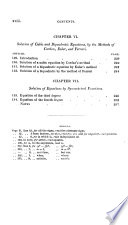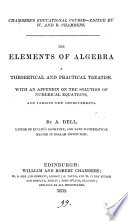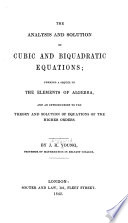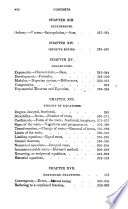 | Charles Davies - Algebra - 1835 - 378 pages
...of VARIATIONS of sign, nor the number of negative roots greater than the number of PERMANENCES. 303. Consequence. When the roots of an equation are all real, the number of positive roots is equal to Hie number of variations, and the number of negative roots is equal to the number of permanences. For,... | |
 | John Radford Young - 1835 - 302 pages
...necessarily, p=p' and r = t^ ; consequently, when the roots are all real, the number of positive roots will be equal to the number of variations, and the number of negative roots equal to the number of permanencies.' CHAPTER. II. ON THE TRANSFORMATION OF EQUATIONS. (19.) Algebraical... | |
 | Andrew Bell (writer on mathematics.) - 1839 - 500 pages
...lie discovered the important theorem, called " the rule of signs," that in an equation whose roots are all real, the number of positive roots is equal to the number of variations of the signs of its terms tяken in succession, and the number of the negative roots to that of the... | |
 | John Radford Young - Equations - 1842 - 276 pages
...and » = »' Consequently, when the roots are all real, the number of positive roots will be exactly equal to the number of variations, and the number of negative roots to the number of permanencies. It must be borne in mind, however, that whether the roots are all real... | |
 | Charles Davies - Algebra - 1845 - 382 pages
...of signs, nor the number of negative roots greater than the number of PERMANENCES. Consequence. 328. When the roots of an equation are all real, the number...number of variations, and the number of negative roots to , the number of permanences. For, let m denote the degree of the equation, n the number of variations... | |
 | Algebra - 1847 - 408 pages
...of signs, nor the number of negative roots greater than the number of PERMANENCES. Consequence. 328. When the roots of an equation are all real, the number...the number of variations, and the number of negative Toots to the number of permanences. For, let m denote the degree of the equation, n the number of variations... | |
 | Algebra - 1848 - 394 pages
...of signs, nor the number of negative roots greater than the number of PERMANENCES. Consequence. 328. When the roots of an equation are all real, the number of positive roots ii equal to Ike number of variations, and the number of negative roots to the number of permanences.... | |
 | Stephen Chase - Algebra - 1849 - 348 pages
...362). Therefore, Cor. i. If the roots of an equation be all real, the number of positive roots must be equal to the number of variations ; and the number of negative roots, to the number of permanences. See § 218. 1, 2, 3. § 362. J.) If any term of the equation be wanting,... | |
 | Bourdon (M., Louis Pierre Marie) - Algebra - 1850 - 386 pages
...of signs, nor the number of negative roots greater than the number of PERMANENCES. Consequence. 328. When the roots of an equation are all real, the number of nositive roots is equal to the number of variations, and the number of negative roots to the number... | |
 | Joseph Ray - Algebra - 1852 - 408 pages
...ciphers). Therefore, if the roots of an equation be alt real, the number of positive roots must be equal to the number of variations, and the number of negative roots to the number of permanences. (See examples, pages 343, 345.) For example, the equation 0:2+16=0, may... | |
| |